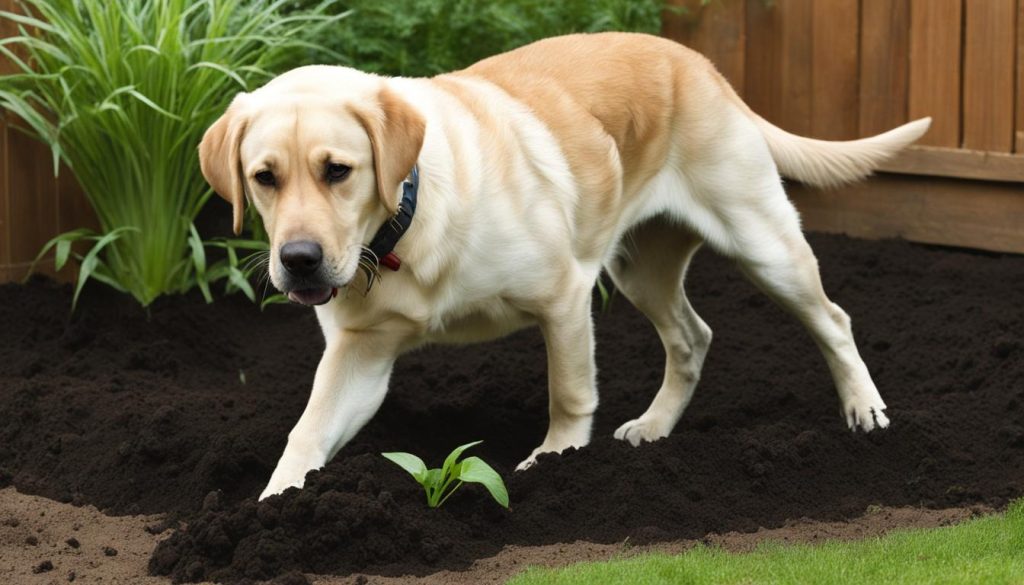As a dedicated Labrador Retriever owner, I have firsthand experience with the charm and challenges that come with raising this breed. Known for their outstanding temperament and undying loyalty, Labradors are the epitome of canine companionship. However, we need to acknowledge that even these affable creatures can exhibit a range of labrador retriever behavior issues. Whether you’re dealing with disruptive chewing problems, an unnerving inclination toward aggression, or the heart-wrenching pangs of separation anxiety, understanding and addressing these behaviors is crucial for maintaining a harmonious household.
Pulling on the leash during walks, incessant barking that disrupts the peace, and signs of fearfulness in unfamiliar situations are all too common. These issues not only affect your furry friend but can impact the well-being of your entire family. But worry not! With the right labrador retriever training tips and a dash of patience, these hurdles are not insurmountable. Let’s work together to enhance our Labradors’ social skills and channel their boundless energy away from destructive behavior toward more constructive pursuits.
My journey of navigating through labrador retriever socialization hurdles and establishing a calm, obedient companion could offer the support and strategies you need. Stick with me, and we’ll explore the depths of these behaviors and emerging solutions to foster a more peaceful coexistence between you and your beloved Lab.
Labrador Retriever Behavior Issues and Solutions
- Addressing labrador retriever aggression requires patience, consistency, and occasionally professional intervention.
- Effective remedies for labrador retriever separation anxiety rely on gradual desensitization and comfort conditioning.
- Proper engagement and alternatives can mitigate labrador retriever chewing problems and leash-pulling tendencies.
- Utilizing various labrador retriever barking solutions will contribute to a more tranquil home environment.
- Early and continuous labrador retriever socialization is the cornerstone of preventing fearfulness and destructive behavior.
- Understanding the root of labrador retriever behavior issues is key to effective management and training.
- Insightful labrador retriever training tips can transform problematic behaviors into positive outcomes.
Understanding Labrador Retriever Behavioral Traits
As I delve into the world of Labradors, I consider myself beyond fortunate to have witnessed their friendly antics and enduring loyalty firsthand. Beneath their well-behaved veneer, however, lies a gamut of common labrador retriever behavior problems that many owners will recognize. Whether it’s a labrador retriever puppy chewing everything in sight or an adult dog displaying inherent frustrations, understanding these behaviors is essential.
Much like us, these canines have their boundaries that when overstepped, can lead to notable labrador retriever training problems. But fear not, for every challenge there’s a strategy waiting to be implemented, and I’m here to guide you through them.
A Friendly and Loyal Companion with Boundaries
One need only spend a moment with a Labrador to see their deep-rooted friendliness and unwavering loyalty. Yet, it’s naive to assume these admirable traits exempt them from routine misbehaviors. Recognizing the limits and setting clear, consistent boundaries can mean the difference between a well-adjusted Labrador and one that runs the household.
Commonplace Behaviors: Chewing, Digging, and Nipping
- Labrador Retriever Puppy Chewing: An instinctual need to explore and soothe their growing teeth often translates to a gnawed shoe or a destroyed pillow. It becomes a test in patience and redirection.
- Digging: While not as glamorous as their retrieving nature, digging is a common behavior rooted in their genes, often leaving gardeners in despair.
- Nipping: A playful nip might seem harmless during puppyhood, but if not corrected early on, it can escalate into a problematic behavior.
The Misconception of Extroverted Natures Free of Fear and Anxiety
I’ve noticed many people believe that an extroverted and sociable breed like the Labrador is immune to fear and anxiety. Yet, this couldn’t be further from the truth. They can be prone to nervousness just like any other breed, and it’s our job as the caretakers to recognize and alleviate these stressors with compassion and proper training techniques.
Dissecting Common Labrador Retriever Behavior Issues
As a proud Labrador Retriever owner, I’ve seen firsthand that, despite their intelligence and good nature, Labs can exhibit behaviors that are both challenging and perplexing. From their puppy days through adulthood, these behaviors can manifest as labrador retriever destructive chewing or as bold as labrador retriever jumping on people. So, let’s dive into the root causes and potential remedies for these common issues among our beloved four-legged friends.

From Destructive Chewing to Barking Solutions
Many Labrador Retrievers have an insatiable need to chew, and without proper guidance, their chewing can become destructive. Household items and treasured belongings can fall victim to their strong jaws. This labrador retriever destructive chewing is often an outlet for boredom or excess energy. To combat this, providing a variety of chew toys and engaging in regular, vigorous exercise can redirect their chewing habits positively.
Similar to chewing, labrador retriever excessive barking may also arise from a lack of stimulation. While barking is natural, finding the right balance is key. Training methods, such as teaching ‘quiet’ commands or using distraction techniques, can be invaluable in managing their vocalizations, ensuring barking is expressed in appropriate situations only.
Managing Excessive Energy and Separation Anxiety
- Labrador Retrievers are known for their boundless energy, which can translate into behaviors such as jumping on people. Structured training sessions that reinforce calm greetings and rewarding four paws on the floor can mitigate these jumpy hellos.
- When it comes to labrador retriever housebreaking issues, consistency is your best friend. Establishing a routine for potty breaks and using positive reinforcement can clear up any confusion and establish good habits.
Separation anxiety is also a concern for many Labrador owners. This can exhibit through destructive behavior when left alone. Crate training, along with incremental desensitization to alone time, can alleviate the stress your Lab feels when you’re away. For more complex cases, seeking help from a professional can introduce new strategies tailored to your Labrador’s needs.
I hope this exploration deepens your understanding and arms you with the tools to ensure a happy, healthy relationship with your Labrador Retriever. Remember, patience and consistency are key in overcoming these common behavior issues.
Labrador Retriever Behavior Issues
As a loving owner of a Labrador Retriever, I’ve observed that despite their generally friendly disposition, Labradors can exhibit certain problematic behaviors. Prominent among these are labrador retrievers barking, digging, and signs of fearfulness. Addressing these issues effectively enhances the bond between us and ensures their well-being.
Labrador retriever barking can sometimes disrupt the peace within our homes. It’s crucial to understand the causes of this behavior. A well-thought-out training program, including teaching quiet commands, can be the solution to managing their vocal expressions.
- Establishing commands like “quiet” when they start to bark
- Ignoring the barking so as not to reinforce the behavior
- Providing distractions and keeping them engaged
When it comes to labrador retriever digging, I’ve found it’s a natural instinct for many dogs, but one that can wreak havoc on gardens. With adequate physical activity and mental stimulation, their desire to dig can be significantly reduced.
- Create a designated digging zone in the yard
- Increase their daily exercise routine
- Use deterrents in non-digging areas
- Offer puzzle toys to redirect their energy
Fearfulness, particularly in rescue Labradors, may have deeper roots. Recognizing and patiently working through these fears is vital; a combination of desensitization techniques along with day-to-day management strategies often proves beneficial.
- Positive reinforcement during fearful situations
- Gradual exposure to mild stressors
- Creating a safe, stress-free zone in the home
Nevertheless, there are instances where avoiding certain triggers may be more realistic than overcoming the fear response. Recognizing when to remove our furry friends from stressful situations is just as important for their emotional health.

Tackling Labrador Retriever Training Challenges
As I delve deeper into the world of raising a Labrador Retriever, I’ve realized that distinguishing between training issues and more ingrained behavior problems is crucial for a harmonious relationship. Taking the leap from frustration to understanding has opened up new avenues for effectively communicating with my Lab.
Training vs. Management: Knowing the Difference
When my Labrador started leash pulling, it was tempting to consider quick fixes or management tricks. However, I soon learned that effective resolution depended upon regular training sessions. Consistency was key—as was patience. Key tactics for managing this common issue included:
- Utilizing no-pull harnesses for immediate relief
- Implementing reward-based training to encourage loose-leash walking
Fostering labrador retriever socialization experiences also proved invaluable. Introducing my Lab to a variety of environments and situations developed his confidence and responsiveness to my commands, making our walks a pleasant experience for both of us.
Addressing Aggression: Prevention and Solutions
While my Labrador is generally good-natured, recognizing early signs of aggression and addressing them head-on is crucial. Proactive strategies included:
- Attending puppy classes for early socialization
- Engaging in consistent obedience training
- Setting boundaries to elucidate acceptable behaviors
Through establishing a firm yet affectionate rapport and maintaining structured training, I aimed to nurture a well-adjusted companion. If an issue did become complex, seeking professional advice was always my next prudent step.
Training challenges like labrador retriever leash pulling can be daunting, but with the right approach, they are just another part of the rewarding journey of raising a Labrador. My experiences have taught me the profound impact that dedicated training and proper socialization can have on my furry friend’s life and my own.
Preventative Measures for Common Labrador Issues
As a devoted Labrador owner, I’ve always believed that preventing unwanted behaviors is far better than trying to fix them once they’ve become a problem. It’s particularly true for issues like labrador retriever destructive behavior and labrador retriever training problems. Let me share with you some effective strategies incorporating early socialization and training to nip these problems in the bud.
Early Socialization and Its Impact on Adult Behavior
My experience has shown me that the key to a well-behaved adult Labrador lies in the experiences they have as puppies. It’s during this formative period that positive interactions and diverse experiences can shape a Labs temperament for life. Whether it’s meeting new people or getting acquainted with other pets, early socialization pays dividends in the form of a confident, well-rounded companion.
- Introduce your Labrador to different environments – from parks to busy city streets.
- Expose them to various sounds, from traffic noises to household appliances, to reduce fearfulness.
- Socialize with other dogs and humans regularly to enhance their interaction skills.
Strategies to Curb Destructive Tendencies Like Biting and Digging
To manage a Labrador’s zest for life without succumbing to destructive behaviors, early and consistent training is vital. Offering suitable outlets for their natural chewing and digging instincts can divert them from targeting your furniture or backyard. The idea is to redirect their energy constructively.
- Provide a variety of chew toys to keep your Labrador’s biting behavior in check.
- Regularly engage in physical activities like fetch and swimming to burn off excess energy.
- Create a designated digging zone to satisfy their burrowing instincts without destroying your garden.
- Set up consistent training sessions focusing on commands like ‘leave it’ and ‘sit’ to manage impulsivity.
Through early and consistent implementation of these strategies, I’ve seen remarkable results in preventing and managing potential training problems. Remember, patience, consistency, and love are your best tools when shaping your Labrador’s behavior.
Rehabilitating Behavior: When to Seek Professional Help
As a devoted Labrador Retriever owner, I’ve learned how crucial it is to recognize when it’s time to seek professional help for labrador retriever behavior issues. Even the most nurturing home environment may encounter concerns such as labrador retriever aggression or labrador retriever separation anxiety. It’s essential to understand that seeking help is a sign of love and commitment to your companion’s well-being.
The Role of a Veterinarian in Behavioral Assessment
When I first noticed changes in my furry friend’s demeanor, I reached out to our veterinarian for an initial assessment. The vet’s input was invaluable in ruling out any physical health issues that could manifest as behavioral changes. This reassuring step provided the peace of mind to pursue further behavioral analysis, knowing my Labrador was physically healthy.
- Health check-up to eliminate medical causes of behavior changes
- Advice on dietary adjustments that may influence mood and behavior
- Recommendations for behavioral specialists or training programs
Working with a Behaviorist: Resolving Complex Issues
If your Labrador is displaying signs of persistent aggression or suffering from acute separation anxiety, it may be time to work with a qualified behaviorist. Personal experience taught me the value of this specialized guidance. They provided tailored strategies suited to my dog’s unique needs that have proven pivotal in managing and resolving these complex issues.
- Creation of a customized management plan for your Labrador
- Retraining techniques to reshape behavioral responses
- Ongoing support and modifications to the plan as needed
The Journey Through a Labrador’s Life: Behavior by Age
Throughout my experience with Labradors, I’ve witnessed how their behavior morphs as they transition from one life stage to another. The chew-happy puppies, brimming with zest, often leave a household with memories of gnawed furniture and misplaced objects. This labrador retriever puppy chewing phase is natural, yet it requires patient training and appropriate chew toys to curb. With persistence, the tendency for playful destruction can be managed, molding them into well-behaved companions.
As Labradors grow, their youthful exuberance often manifests in some less-than-desirable habits. Adolescent Labs are known for their propensity to express their energy by jumping on people, a behavior that can easily overwhelm guests. Through consistent and gentle correctional training, I’ve learned to redirect this enthusiastic greeting into a more socially acceptable welcome. Similarly, their penchant for digging could turn pristine gardens into excavation sites if not addressed with ample exercise and entertainment.
Adulthood brings about a notable shift towards reliable and poised conduct. Yet, the occasional outburst of labrador retriever barking or a resurgence of fearfulness roots in their past experiences or environmental changes and needs understanding and reassurance. My watchful attention to these subtle cues ensures a continued bond and a harmonious home. Finally, as they approach their senior years, a Lab’s activity levels may wane, but the love and fidelity they exhibit only deepen. It’s a remarkable transition, observing a Lab’s life unfold, and it’s this understanding of the ebbs and flows of their behavior that equips me to provide the care and guidance they deserve at every age.
FAQ
What are some common behavior issues in Labrador Retrievers?
Some common behavior issues include destructive chewing, barking, digging, leash pulling, aggression, separation anxiety, jumping on people, excessive barking, and housebreaking issues. These behaviors stem from various factors, such as boredom, lack of exercise, or insufficient training and socialization.
How can I address my Labrador’s chewing problems?
Redirect chewing by providing appropriate chew toys, ensure they have enough physical and mental exercise, and use deterrents on items you don’t want them to chew. Consistent redirection and positive reinforcement can help address this behavior.
My Labrador has started to pull on the leash during walks. How can I train them to stop?
Leash pulling can often be rectified through the use of a no-pull harness or head halter. Consistent leash training, teaching the ‘heel’ command, and reinforcement of calm walking behavior with treats and praise can also be effective.
Are there any solutions to Labrador Retrievers’ excessive barking?
To solve excessive barking, first identify the cause, such as boredom or alertness, then address it through increased exercise or mental stimulation. Training your Labrador to respond to quiet commands and using positive reinforcement when they are silent can also help manage barking.
How can I help my Labrador with separation anxiety?
You can help alleviate separation anxiety by practicing gradual departures, ensuring your Labrador has comfort items, employing desensitization techniques, and considering crate training. In severe cases, consult with a professional behaviorist or veterinarian.
Why does my Labrador dig, and how can I stop it?
Digging can be a natural instinct or a sign of boredom. To stop digging, provide ample exercise, distract them with toys, create a designated dig area, and discourage digging in unwanted places with barriers or repellents.
What should I do if my Labrador is showing signs of aggression?
If your Labrador is showing aggression, it’s essential to ensure everyone’s safety first. Consult with a professional to assess the behavior, and avoid any known triggers while a treatment plan is developed. Proper training, management, and sometimes medication may be necessary.
How important is early socialization for my Labrador?
Early socialization is crucial for Labradors. It helps them develop good behaviors and reduces fearfulness and potential aggression. Exposing them to different people, animals, and environments early on will lead to a well-adjusted adult dog.
When is it time to seek professional help for my Labrador’s behavior issues?
Seek professional help if the behavior is persistent, poses a danger to people or animals, or if you’ve tried initial training with no success. A veterinarian can rule out any medical issues, and a behaviorist can offer specialized training and strategies.
Does the behavior of Labrador Retrievers change as they age?
Yes, Labradors’ behavior evolves through their life stages, each with unique challenges. Puppies exhibit chewing and clinginess, adolescents may test boundaries, adults are typically more reliable, while seniors may slow down and need more comfort and care.






